- News
- Reviews
- Bikes
- Components
- Bar tape & grips
- Bottom brackets
- Brake & gear cables
- Brake & STI levers
- Brake pads & spares
- Brakes
- Cassettes & freewheels
- Chains
- Chainsets & chainrings
- Derailleurs - front
- Derailleurs - rear
- Forks
- Gear levers & shifters
- Groupsets
- Handlebars & extensions
- Headsets
- Hubs
- Inner tubes
- Pedals
- Quick releases & skewers
- Saddles
- Seatposts
- Stems
- Wheels
- Tyres
- Tubeless valves
- Accessories
- Accessories - misc
- Computer mounts
- Bags
- Bar ends
- Bike bags & cases
- Bottle cages
- Bottles
- Cameras
- Car racks
- Child seats
- Computers
- Glasses
- GPS units
- Helmets
- Lights - front
- Lights - rear
- Lights - sets
- Locks
- Mirrors
- Mudguards
- Racks
- Pumps & CO2 inflators
- Puncture kits
- Reflectives
- Smart watches
- Stands and racks
- Trailers
- Clothing
- Health, fitness and nutrition
- Tools and workshop
- Miscellaneous
- Buyers Guides
- Features
- Forum
- Recommends
- Podcast
review
 SRAM Apex groupset - chainset
SRAM Apex groupset - chainset£499.99
VERDICT:
Delivers a good spread of gears in a light and inexpensive package – ideal for sportives
Weight:
2,419g
Contact:
www.saddleback.co.uk
At road.cc every product is thoroughly tested for as long as it takes to get a proper insight into how well it works. Our reviewers are experienced cyclists that we trust to be objective. While we strive to ensure that opinions expressed are backed up by facts, reviews are by their nature an informed opinion, not a definitive verdict. We don't intentionally try to break anything (except locks) but we do try to look for weak points in any design. The overall score is not just an average of the other scores: it reflects both a product's function and value – with value determined by how a product compares with items of similar spec, quality, and price.
What the road.cc scores meanGood scores are more common than bad, because fortunately good products are more common than bad.
- Exceptional
- Excellent
- Very Good
- Good
- Quite good
- Average
- Not so good
- Poor
- Bad
- Appalling
Back in December we did a First Ride report on the new SRAM Apex groupset. At the time, we liked it. Move on two months and we've done a bunch more miles on the Apex-equipped test bike, and we still like it. We like it a lot, in fact.
But before we gush any further, let's have a look at the kit in more detail. The Apex range is less expensive than SRAM's other well-established ranges - Rival, Force and Red - so rather than carbon, we're talking mainly Aluminum alloy here, plus some steel on the obvious bits such as the cassettee cogs and front mech cage. The colour is mainly gloss black, with the steel bits being, er, steel coloured.
The groupset includes crankset (cranks and chainwheels), cassette, brakes, controls (combined brake and gear levers), front and rear derailleurs, bottom bracket and chain. Here's how we rate the individual components...
Chainset & Cassette 8/10
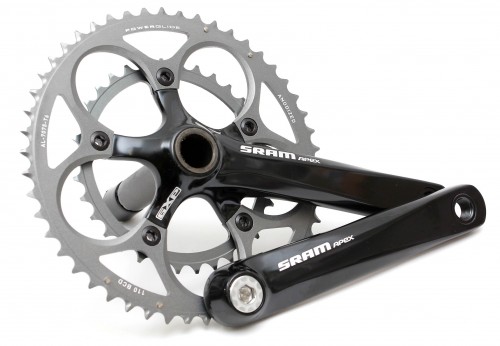
As with SRAM's other ranges, under the Apex banner there's a wide choice of sizes for chainwheels (eg 53/39 or 48/34 - for cyclocross) and 10-speed cassettes (eg, 11-23T, 12-25T or 12-28T), but the headline option - and the set-up we're testing - has standard 50/34 compact rings and a 10-speed cassette with 11-32T.
Was that 32T? On a road bike? Yes indeed. It may look like a mountain bike cassette, but teamed up with a compact chainset it gives low gears that you'd normally only get with a triple. But that's where the similarity stops. The chainset weighs less than an equivalent quality triple. You also get a lower Q-factor (ie, the bottom-bracket axle is shorter, so your feet are closer together) meaning pedalling is more efficient than with a triple. It seems to be a win-win situation. SRAM's marketing blurb bills it as 'WiFli' - meaning wider, faster, lighter. And to cap it all, it's less expensive than a triple set-up of comparable quality such as Shimano's 105.
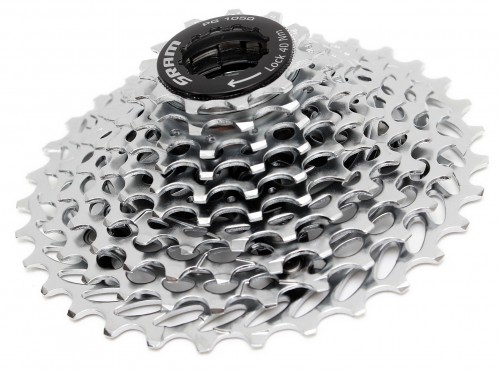
All well and good, but does this set-up actually work? Yes. Nearly all the ratios are available, with chain-rub only in 50:32, 34:11 and 34:12, which you'd never normally use anyway. (To be honest, you'd never normally use the gears next door either - 50:28 or 34:13 - but they do engage.)
So another advantage of this compact chainset with a 10-speed cassette over a triple is a higher proportion of usable gears (17 out of 20) however the triple will still give you the greater number of useable gears.
OK, so the Apex 11-32 works, but do you *need* this granny gear on a road bike? In our view, it depends what you ride. If you ride sportives that feature steep hills (and there's a few that meet this description) lower gears make it easier. And that means less effort on the legs. And that means energy saved to use later on. And that means getting round in a faster time, or reaching the finish feeling slightly fresher than usual.
Here are some real examples: Through the 2010 season I rode a good batch of fairly tough sportives across the UK, with killer climbs including Mow Cop, Peak Hill, Winnats Pass and many other 25%ers. Where other riders were lunging all over the road to keep 34:27 turning (or simply walking) on these hills, we were still going nicely on 34:32. With the time gained and energy saved we were doing 100-mile sportives well under our personal objective of 6 hours. Not setting the world alight, but respectable accomplishments. So yes, I need the granny gear. That's why we like the Apex set-up so much.
To counter all these positives, there is one disadvantage: With 20 gears between highest and lowest (instead of a theoretical 30 you'd get with a triple) the jumps between the ratios are bigger. With a complete run of 11, 12, 13, 15, 17, 19, 22, 25, 28, 32T on the cassette on test, this means on occasion you find yourself wishing for a 14T or 16T cog that isn't there. But this is rare, and not a major issue. If it's something you think might be a problem, other Apex cassettes with closer high-to-middle ratios are available, such as 12, 13, 14, 15, 16, 17, 19, 21, 24, 32T.
Weight: Chainset 889g
Weight: Cassette 12-32 318g
Controls 8/10

The controls feature a separate gear lever, behind the main brake lever. So to change gear you move the gear lever, rather than swinging the brake lever sideways as on Shimano and Microshift. Changing gear is via the 'double-tap' system common to all SRAM brakes, meaning you push the gear lever in the same direction to change up and down. Hard (two clicks) for up a gear; not so hard (one click) for down.
It takes a day or two of familiarisation if you're used to Shimano or Campag, and (like all SRAM levers) it feels a bit clunky compared to the cleaner lever-motion provided those other two brands. But down on the sharp end, changing is smooth and quick, with indexing precise and positive. No slips on the cassette. No sucks or jumps on the chainwheels. One major positive is that when you're on the drops you can pull the control lever back and use it to shift both up and down without having to go to the hoods or reach for a lever. That's certainly an improvement over either of the other two systems.
Like all indexed systems the cables can get out of register. If you've used Shimano or Campag gear you'll be used to 'feathering' changes when things aren't quite spot on, pushing the lever and feeling for the change. Sometimes the shift doesn't register, and you slip back down to the smaller cog. This can be annoying on a climb, but it's worse on SRAM: as soon as you're committed to a shift it's either up or down, there's no going back to where you came from. So if you miss a shift up the block on a hill you'll end up in a higher gear than when you started, and you'll grind to a halt on hills a couple of times before you remember to make sure it's clicked in
The gear lever is easy to reach when you're riding on the hoods, and especially easy when on the drops, as the separate gear lever is nearer your fingers. Comfort-wise, the hoods are big and well-padded enough to rest your hands on pretty much all day (we've done it), so no worries in that department.
Weight: 352g
Rear Derailleur 9/10
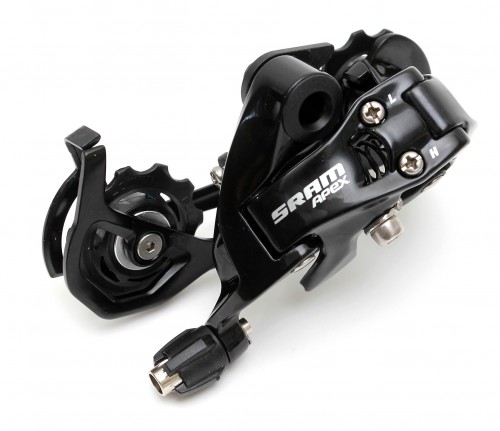
The rear mech on the Apex groupset comes in two varieties: short cage for most cassette sizes, and a mid-cage version for the 11-32T cassette on test. The longer cage is to hold the jockey wheels farther apart, which is required to take up the extra slack in the chain, which is a little longer than usual to deal with the wide range of chainwheel and cog sizes.
With the Apex being SRAM's entry-level range, this is where you might expect to see compromise in performance. But not a bit of it. In hundreds of miles of riding our test kit, the rear mech went up and down the cassette smoothly every time, never missing a beat.
Weight: 217g
Front Derailleur 8/10

These are available in to band on sizes: 31.8m and 34.9 as well as a braze on version. As with the rear mech, the front mech worked perfectly too. For adjustment, there just a medium setting between high and low, with no ability to micro-trim, but you don't need it. As mentioned above, the chain rubs on the cage only in gears you wouldn't use anyway.
In the road.cc test lab, and out on the road, we deliberately abuse the gears on a few occasions - simultaneously changing up on the rings and down on the cogs (or vice versa), and forcing the chain to drop from big ring to little ring half-way up a hill while keeping pretty much full pressure on the pedals - just to see if the mechs could cope. They did.
Weight: 94g
Brake Callipers 8/10
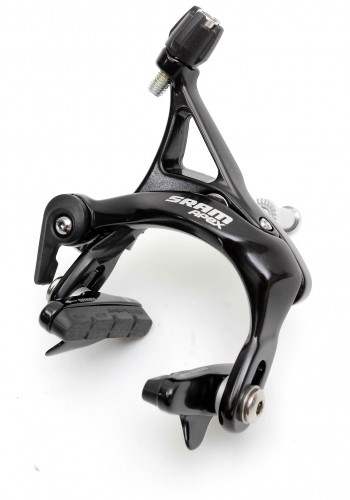
In terms of performance, there's only one thing you need from brake callipers: to control your speed. And once again, the Apex kit does the job perfectly well. On big descents coming into bends, the braking felt clean and positive every time. Riding on the hoods, there's easily enough leverage to bring the bike to a complete stop pretty damn quickly, without having to go onto the drops for extra force.
The reach on the callipers (ie, the distance between the top of the inside of the calliper and the lowest position of the brake shoes) is generous. There's room for mudguards, depending on your frame clearance, or larger tyres - SRAM says the brakes will take up to 28mm. You might even get 25mm tyres *and* mudguards in there - again depending on your frame clearance - ideal if you'll use the Apex on a winter bike or for audax rides.
Weight: 320g
Chain 7/10

The chain provided with the Apex groupset is the PC1031. It's relatively basic, compared to the 1051 and 1071 that come with Rival and Force groupsets, but once again it does the job perfectly, meshing neatly with cogs and rings and always changing smoothly.
The chain comes with a 'Powerlock' joining link. No tools are required to use the link itself when connecting the ends of the chain, but unlike some other brands, the Powerlink is designed NOT to be opened again.
Overall, we found the SRAM Apex groupset ideal for entry-level riding. And it's pretty darn good for more demanding riders too, or with more expertise, especially those that sometimes need lower gears.
Weight: 229g
When we published the First Ride report back in December, the discussion that followed in the Comments section was quite lively. There was a feeling among some correspondents that lower gears were some kind of a wimpish option. We beg to disagree. If you don't need anything lower than 34:27 to get up the steep hills that feature in many sportives, that's fine. And if you generally ride sportives in less severe landscapes, that's fine too. But if you ride sportives on gears that are too high as a 'challenge', deliberately spurning lower gears because it's somehow 'cheating', then why not - as another corresponded suggested - ride the whole thing on a fixie? And for good measure, why not screw down your back brake so it rubs on the wheel as well? For the rest of us, anything that makes cycling easier, faster or more enjoyable - and comes at a fair price - has to be a good thing.
Verdict
For most riders tacking steep hills in tough sportives, lower gears will always come in handy, and the SRAM Apex groupset delivers them in a neat, light and inexpensive manner.
road.cc test report
Make and model: SRAM APEX Groupset
Size tested: 50-34 / 11-32
Tell us what the product is for, and who it's aimed at. What do the manufacturers say about it? How does that compare to your own feelings about it?
irst 11-32 cassette on the road. You like to climb long mountain passes, or your local hill, but don't want clumsy triple cranks on your bike? With the first 11-32 cassette for the road, and our new SRAM Apex compact crankset, you will have a wider gear range than the most popular triple combinations. A wider gear ratio means you can climb and descend more efficiently. You also get all of our unmatched technical advantages like Zero-loss, reach-adjust, and DoubleTap shifting. SRAM Apex, wherever the road takes you.
Rate the product for quality of construction:
8/10
Rate the product for performance:
8/10
Rate the product for durability:
8/10
Rate the product for weight, if applicable:
8/10
Rate the product for comfort, if applicable:
7/10
Rate the product for value:
8/10
Did you enjoy using the product? Yes
Would you consider buying the product? Yes
Would you recommend the product to a friend? Yes
About the tester
Age: 50 Height: 5ft 10 / 178cm Weight: 11 stone / 70kg
I usually ride: an old Marin Alp My best bike is: an old Giant Cadex
I've been riding for: Over 20 years I ride: A few times a week I would class myself as: Experienced
I regularly do the following types of riding: touring, club rides, sportives, mtb,
Latest Comments
- joe9090 6 min 56 sec ago
Belgium is lawless and they don't give a fig. They also hate their neighbours, as do their neighbours hate them. They cannot even speak Dutch...
- Secret_squirrel 15 min 2 sec ago
Thats if you believe that a slightly bigger bearing surface translates in any meaningful way to "pedaling stiffness" which to my mind is the...
- quiff 13 min 37 sec ago
"John and Jackie are giddy for the gas"?! I suspect N14GAS was already a post hoc rationalisation based on what 'GAS' suffix plates were actually...
- chrisonabike 16 min 3 sec ago
"I put the Limes in the cul-de-sac, stacked them all up..."
- chrisonabike 20 min 50 sec ago
Everyone carrying more / brighter searchlights will fix things? Perhaps it helps sometimes, but I think this leads to other issues. We're already...
- SecretSam 22 min 36 sec ago
Lake's naming and sizing: never knowingly comprehensible. Good shoes, baffling range.
- hawkinspeter 25 min 58 sec ago
Yeah, I doubt if Arron Banks would be happy visiting "little Somalia" (as he referred to Bristol) and certainly I don't think Bristol's residents...
- ChasP 1 hour 2 min ago
It could be used as a reliable comparison without any calculations.
- jaymack 2 hours 17 min ago
A lab in your hand but no cash in your pocket. But the app' is free which of course makes all the difference.



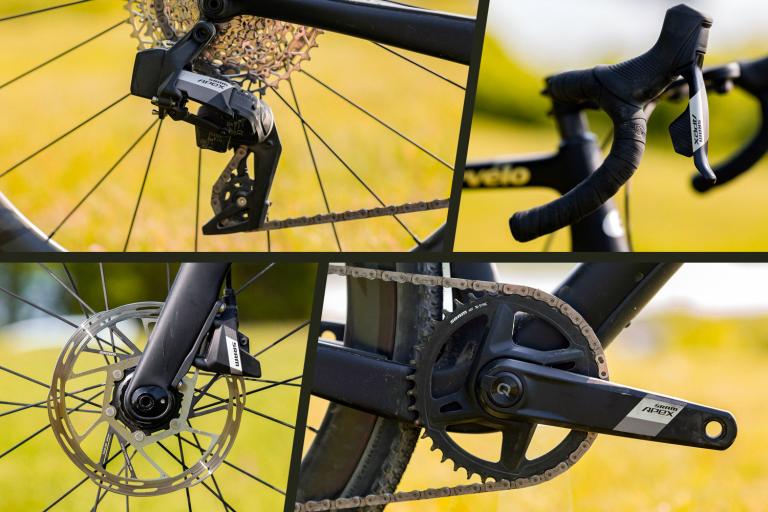
Add new comment
14 comments
One click for up and 2 for down not vice versaa or is it dif for apex?
or is it dif for apex?
the kickshift is your friend, step-hent. embrace the kickshift
it can't be run fixed, no. SA do a 3spd fixed hub but it's quite spendy...
2 speeds? pah. I've only got one. Or 20, depending on which bike I'm on. ah well.
Actually, Dave, how is the 2 speed? I live on a big hill, but otherwise my commute is relatively flat, so I'm fine on a single speed for most of the way and then always have to really churn it to get over the last lump. 2 speeds might just solve my problem.... though I presume it cant be run fixed...
(waits for... '2 speeds? pah')
I'm back on 2 speeds now. 20? pah.
True, but then you don’t have the 32T big cog to give the ultra low bottom gear with a compact chainset, which (like it, loathe it, or dismiss it as hype) is the aspect that sets this Apex cassette apart from other road cassettes.
I find that my ankles / shoes can catch on some chainsets, which is why I pay attention to "Q-Factor". But, actually, one of the chainsets I don't like is a Truvativ Elita GXP double, presumably the same as the Apex as far as ankle clearance goes. (The Apex cranks do look like they have a friendlier shape without nasty edges.) So I guess that what I'm really interested in the distance between the outside of crankset at the axle and the outside at the pedal thread. My Campagnolo UT chainset has loads of room. BB30 chainsets appear to have better ankle clearance too.
Not sure about Q Factor - I'd be interested in seeing data backing up the 'smaller is better'. I suspect there is a actually a range within which there any efficiency improvements are so small that it's not worth the majority worrying about.
Oh, and on the smaller is better, I'm sure I read that a certain bloke called Lance ditched a prototype Trek TT bike because he was actually slower on it. The difference between it and the older model ..... a smaller Q factor.
If I seen a person on a road bike & seen this gruppo on the bike id feel they had a pretty good set-up for all terrain.
I recently got the Apex c.set & am seriously impressed how easy it is to adjust and maintain - not that it needs much maintaining - tho' am not plussed on the shifter' style, preferring Shimano.
@ smutchin. It's a fair point. Maybe sportive riders don't need 50x11. Or at least would be happy to trade that top gear for closer spacing in the middle of the block. As I mention in the feature, the Apex cassette is also available as 12, 13, 14, 15, 16, 17, 19, 21, 24, 32T, which would give closer spacing, so that might be worth considering. However, the Apex cassette is not available as 13T and upwards. As far as I know, no SRAM cassettes have a 13T smallest cog.
no they dont but you can use a shimano ultegra 13-25, which i use with SRAM rival setup.. works fine.
(they also do 14-25, 15-25, + 16-27)
http://cycle.shimano-eu.com/publish/content/global_cycle/en/nl/index/pro...
Nice review. Looks a good product.
I have to wonder, though - how many sporting riders really and truly need a 50x11 or even 50x12 top gear? Closer spacing between gears would be possible with a lower top end.
A triple with 12-25 or 12-27 cassette can do this across all 3 chainrings, yet only add about 200 grammes to the weight of the bike. If you're that bothered about weight then eat less.
And for those of us not racing I think mentioning Q-factor is mainly marketing hype. SRAM don't make a triple chainset.
Schwag please!